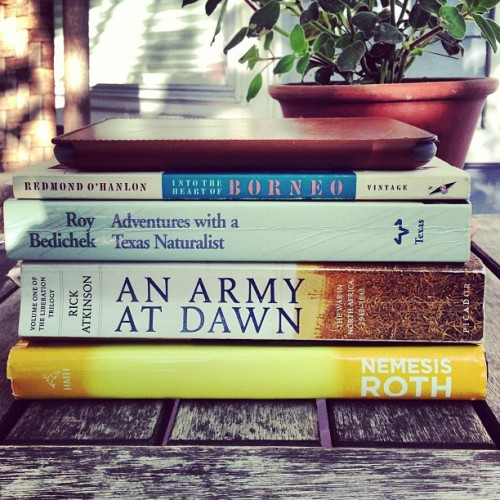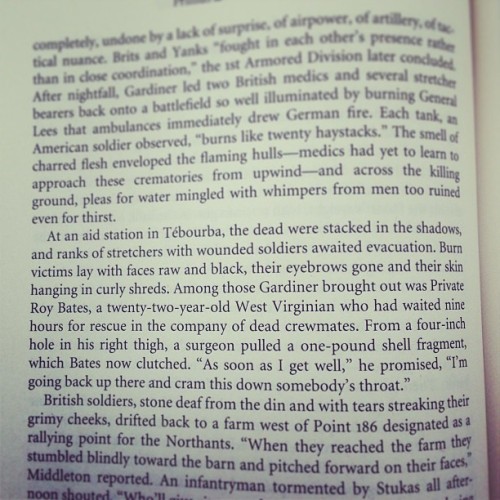
When I’m at work I do a lot of reading, so when I’m not at work, I try to do a lot of reading.
Books first.
I usually read 3 or 4 books at once — or, you know, going back and forth. Right now it’s these.
I’ve been meaning to read Redmond O’Hanlon’s Into the Heart of Borneo for years, finally had the good sense to bring it along on a sort-of-work trip, and found it a roaring delight from page one, full of wit, surprises, adventures, and splendid writing. This passage includes almost all of that, so why not:
Call for the Dead is John LeCarré’s first novel. (It’s obscured in my photo — of course it’s obscured! — in the Kindle atop the stack.) Frightening how full a skillset this young, unschooled novelist wielded; the novel, which also gives us George Smiley for the first time, brings immense pleasure. And LeCarre’s introduction to this re-issue, which is essentially a memoir of his earliest days as a writer, is priceless.
As to writing—yes, since abandoning boyhood poetry, I had had one shot. While I was still teaching at Eton, the Bodley Head asked me to write a German reader for them, to be aimed at the Ordinary Level examination students. So I wrote them a story about a pavement artist who one afternoon produced a masterpiece in pastels on a paving stone in Trafalgar Square: a Mona Lisa. Better. And he knew. Rain was coming, so was the rush hour. He had no fixative. The paving stone belonged to the Council, not to him. My story was a nice little metaphor, now that I come to recall it, for my frustrated talent, even if I didn’t know what talent it was that was lying on the ground unregarded by the hurrying passersby. Needless to say, the story was unsuited to the Bodley Head’s purposes, and they turned it down. Years later, Graham Greene, who was some kind of co-opted director of the Bodley Head, who published him, wrote to me suggesting that I go to them. But that’s writers for you: I had not forgiven them, and I never will.
He goes on to describe the origin of the novel’s heroine. (Note: He mentions here ‘the trays of files of men and women I was supposed to suspect’; he’s referring to the real-life files of questionable persons that it was LeCarré’s real-life task to review in his job at MI5.
I wrote in penny notebooks. On the train to and from Great Missenden, in lunch hours, in the grey morning hours before going off to work. Ann, my wife at the time, typed the stuff out; we were broke, but we risked an Olivetti portable on hire purchase at a few shillings a week. I pitched straight into the story, no messing with outlines, skeletons or flow charts. I hadn’t the smallest idea where I was going. But I had Smiley, I had my trays of files of men and women I was supposed to suspect, but had never met. And I had in my memory a little crushed Frenchwoman in the hospital at Chamonix when I had been skiing there soon after the war. She had been staying at my hotel, and when the manager told me she had broken not just one but both her legs, I went to visit her.
Adventures with a Naturalist is the signature work of Roy Bedichek, one of three mid-20th-century Texas historian-folklorist-writer-naturalists (along with J. Frank Dobie and Walter Prescott Webb) who wrote with astonishing freshness and courage about everything from insects to the insanity of right-wing Texas politics. All three were heroes to my mother and godfathers to the likes of governor Anne Richardson and novelist-naturalist Rick Bass, who wrote the foreword for this edition. This volume shows Bedichek to be a match for Thoreau or anyone else when it comes to clean relation of close observation. It’s a beautiful book.
An Army at Dawn, by Rick Atkinson, is incredible: now and then uneven, as one might expect from a 250,000 history that is part of a trilogy; but fascinating throughout and extremely sharp at its best:

Roth’s Nemesis: I’m usually all in with Roth, but this one, while good — and a book that would be quite impressive from an unknown writer — I found disappointing. Maybe I’m missing something.
I also read Transatlantic, by Colum Mccann. Liked it, but not as much as I expected to.
Shorter fare:
Best science bits I read:
In Dying Brains, Signs of Heightened Consciousness by Ed Yong. Strange. The story too.
“The Fall and Rise of Gene Therapy.” Carl Zimmer profiles the scientist who comes back from a medical disaster, and brings gene therapy back with him.
Study: Rising Military Suicide Rate Not Linked To Deployment I had suspected this was the case. Because But it’s not PTSD! Bad research distorts our understanding of a serious disorder. (And my own PTSD Trap.)
The Great Recession, genetic sensitivity, and maternal harsh parenting Interesting, clever study that seems to support the orchid-dandelion hypothesis I’m writing a book about. The mothers who reacted to harsh economic conditions by growing more harsh with their children also (as a group) reacted to improving conditions by amping up their warmth the most.
A Race to Save the Orange by Altering Its DNA. Amy Harmon does her inimitable thing; on GMOs and OJ.
The Science of Handwriting: Scientific American Paywalled, alas (I wish SciAm had a pay-per-read option). But Brandon Keim here takes a really smart look at science suggesting that handwriting has some cognitive pluses that typing does not. This science in question is all provisional. Keim’s piece is a model of how to handle science that is both tetchy and early in its curve. Plus — whatever he was using — he writes beautifully.
Pieces of mind: introducing the Guardian’s new psychology blog An incredible group of scientists start a new blog. Must-follow if you’re into neuro-psych.
In Need of a New Hip, but Priced Out of the U.S. Yet more evidence that the money-changers have thoroughly taken over the U.S. medical system. No one looking at our system would conclude it’s about delivering medicine. They could quite sensibly conclude it’s about collecting money.
The Arsehole Gene
The science of animal consciousness At Aeon
MRI Shows Twins Fighting in the Womb – YouTube You can thank BoingBoing’s expectant @maggiekb1 for that.
Deeply disturbing stories about NSA spying on us:
How Laura Poitras Helped Snowden Spill His Secrets
Why Privacy Matters Even if You Have ‘Nothing to Hide’
The NSA is turning the internet into a total surveillance system
Email service used by Snowden shuts itself down, warns against using US-based companies
Other delights:
Virginia Woolf on How to Read a Book
‘The Music Is Waiting to Be Tapped’: Listening in the Era of the Stream Alexis Madrigal on vinyl, etc.
Alluring unread things on my Read It Later list:
Genetic relationship between 5 psychiatric disorders estimated from genome
Everyday insanity: Psychosis and the mundane by Vaughan Bell
The 25 Best Websites for Literature Lovers – Flavorwire
For another, doubtless more comprehensive round-up — though I bet he missed the Bedicheck — see my friend Ed Yong’s weekly I’ve got your missing link right here updates (here’s last week’s), which come out every Saturday once Ed finally gets out of bed and finishes the long job of brushing his teeth.
Go next for O’Hanlon’s “In Trouble Again.” It’s got a brilliant, chilling, comical lede chapter that begins with a discussion of Chagas disease, leishmaniasis, and the nightmarish candiru.
Thanks, Bryan – I’ll check it out.